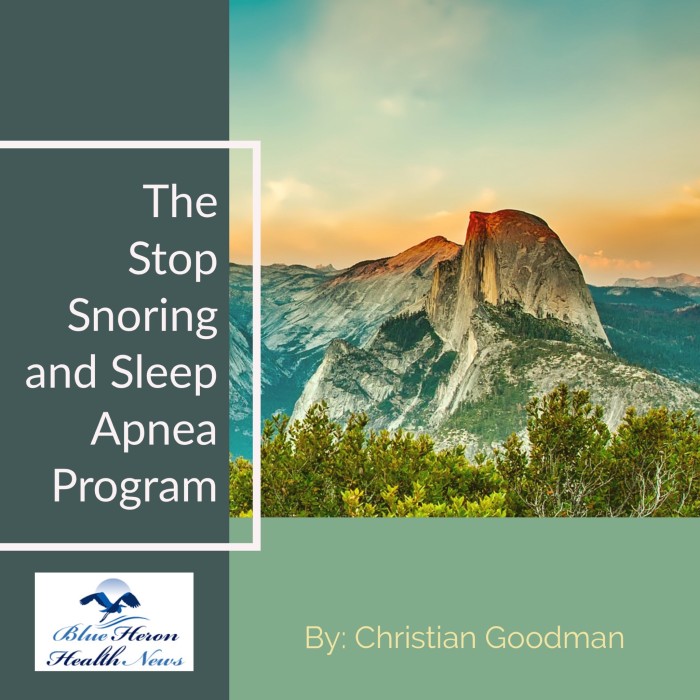This eBook from Blue Heron Health NewsBack in the spring of 2008, Christian Goodman put together a group of like-minded people – natural researchers who want to help humanity gain optimum health with the help of cures that nature has provided. He gathered people who already know much about natural medicine and setup blueheronhealthnews.com. Today, Blue Heron Health News provides a variety of remedies for different kinds of illnesses. All of their remedies are natural and safe, so they can be used by anyone regardless of their health condition. Countless articles and eBooks are available on their website from Christian himself and other natural health enthusiasts, such as Julissa Clay , Shelly Manning , Jodi Knapp and Scott Davis. The Stop Snoring And Sleep Apnea Program™ By Christian Goodman The Stop Snoring and Sleep Apnea Program is a well-researched program created to help stop snoring and sleep apnea so that you can have a good night sleep. The techniques that you will learn from this program works immediately. It will only take you 3-7 minutes to perform these simple exercises that the author has recommended but the results that you will get will help you have a good night sleep as soon as tonight. Within a week, snoring will be a thing of the past.
|
History of Sleep Apnea Awareness
The background of the consciousness of sleep apnea is a history that evolved with time as key milestones built up to greater awareness and intervention of the disease:
Early Accounts (Before 1900s): Humans saw symptoms that bore resemblance to sleep apnea like breathing trouble and snoring but did not understand or comprehend it. There was no term to what is today known as sleep apnea.
1930s-1950s: The earliest significant medical discoveries happened in the early 20th century. In 1935, British physician Charles P. G. Clark documented the symptoms of obstructive sleep apnea in an article regarding a patient having trouble breathing during sleep. It was not however established as such a specific disorder back then.
1960s-1970s: The phrase “sleep apnea” began to be utilized and coined increasingly. In 1965, Dr. Alfred S. Hoch reported an occurrence of “obstructive sleep apnea” in patients with persistent loud snoring and daytime somnolence. Studies during this period began to explore the physiological aspect of sleep and sleep disruption, yet sleep apnea was considered an unusual and specialty issue.
1970s-1980s: Awareness slowly increased as scientists like Dr. Christian Guilleminault and his colleagues in the 1970s and 1980s made important strides. Guilleminault coined the term “sleep apnea syndrome” and conducted much work to solidify it as linked to several illnesses like hypertension, cardiovascular disease, and even decline in mental acuity. Polysomnograph development, a device to monitor sleeping habits, also made it easier to identify sleep apnea through sleeping tests.
1990s: The 1990s witnessed a boom in sleep apnea awareness. With the introduction of continuous positive airway pressure (CPAP) therapy in the late 1980s, effective treatment became available to many, and sleep medicine was a new discipline. As news of the effect of sleep apnea on overall health spread, public awareness grew, especially through campaigns by organizations like the American Sleep Apnea Association.
2000s-Onward: Recognition of sleep apnea has been increasing further, particularly with the advent of media coverage and web health websites. Institutions like the National Sleep Foundation and the American Academy of Sleep Medicine have heightened campaigns to enlighten the population about the signs, dangers, and therapies for sleep apnea. Sleep apnea is now viewed as a common condition, especially in people who are overweight, middle-aged, or have certain illnesses like hypertension or diabetes.
Now, sleep apnea is recognized as a serious medical condition, and treatments like CPAP therapy, oral appliances, and lifestyle changes are widely accessible. Increased awareness has also introduced better diagnostic tools, including home sleep tests, and more research into the long-term consequences of untreated sleep apnea.
The treatment of snoring has progressed over the years with studies having enlightened us more on the causes and impacts of snoring. Let’s take a look at the history of treatments of snoring:
1. Traditional Remedies (Ancient and Early Years)
Home Remedies: In times past, people attempted herbal treatments, changes in sleeping position, and even lifestyle adjustments such as alcohol abstinence before sleeping. Snoring was thought to be decreased by sleeping on one side as opposed to sleeping on the back.
Surgical Approaches: In the early 20th century, procedures to remove excess tissue within the throat or palate, e.g., tonsillectomies or uvulopalatopharyngoplasties (UPPP), were commonly carried out for severe snoring.
2. CPAP Introduction (1980s)
The CPAP machine, created in the 1980s, changed therapy for snoring and sleep apnea. The machine is composed of a nose or mouth mask that blows air into the airways at all times to ensure they remain open.
CPAP subsequently became the gold standard for obstructive sleep apnea snorers, despite having the drawback of being uncomfortable and cumbersome for some individuals.
3. Oral Appliances (1990s)
Mandibular Advancement Devices (MADs) emerged as a less intrusive alternative to CPAP. They are used like a mouthguard and protrude the lower jaw to prevent airway obstruction, thereby reducing snoring.
These gadgets are still widely employed for patients who experience mild to moderate sleep apnea or snoring.
4. Laser Procedures (2000s)
Laser-Assisted Uvulopalatoplasty (LAUP) was another more popular surgical method. A laser is used to ablate or diminish excess tissue in the throat, i.e., the uvula, to increase the size of the airway.
Radiofrequency Ablation (RFA) also evolved in early 2000s, where the goal was to target soft tissue within the airway using radiofrequency energy to reduce the size of the tissue and improve breathing.
5. Minimally Invasive Procedures (2010s)
Pillar Procedure: A minimally invasive procedure where small rods of polyester are inserted within the soft palate to stiffen the tissue and prevent it from vibrating (producing snoring).
Thermal Ablation: Uses heat to reduce the size of the tissues that cause snoring, with a shorter recovery time than more aggressive procedures.
Injection Snoreplasty: A procedure where a chemical is injected into the soft palate to reduce tissue size and reduce snoring.
6. Lifestyle and Behavioral Changes (Today)
Today, the treatment of snoring also involves lifestyle change like weight loss, reduced alcohol consumption before bedtime, and the avoidance of sedatives that lead to relaxation of the throat muscles.
Sleep hygiene and position therapy (sleeping on one’s side) have remained a standard in non-surgical treatment.
7. Emerging Technologies (2020s and Beyond)
Smart Devices: Novel smart wearables, such as sleep-tracking devices and even smart pillows, are being utilized to monitor snoring and adjust sleeping positions or provide users with feedback to reduce snoring.
Ongoing Research: Ongoing research utilizing genetics is studying tailored treatment of snoring and sleep apnea based on an individual’s specific anatomy and sleep habits.
Actually, treatments for snoring have evolved from simple remedies to technology and surgery, and many solutions are available depending on the cause and severity of snoring.

The Stop Snoring And Sleep Apnea Program™ By Christian Goodman The Stop Snoring and Sleep Apnea Program is a well-researched program created to help stop snoring and sleep apnea so that you can have a good night sleep. The techniques that you will learn from this program works immediately. It will only take you 3-7 minutes to perform these simple exercises that the author has recommended but the results that you will get will help you have a good night sleep as soon as tonight. Within a week, snoring will be a thing of the past.
This eBook from Blue Heron Health NewsBack in the spring of 2008, Christian Goodman put together a group of like-minded people – natural researchers who want to help humanity gain optimum health with the help of cures that nature has provided. He gathered people who already know much about natural medicine and setup blueheronhealthnews.com. Today, Blue Heron Health News provides a variety of remedies for different kinds of illnesses. All of their remedies are natural and safe, so they can be used by anyone regardless of their health condition. Countless articles and eBooks are available on their website from Christian himself and other natural health enthusiasts, such as Julissa Clay , Shelly Manning , Jodi Knapp and Scott Davis. |
